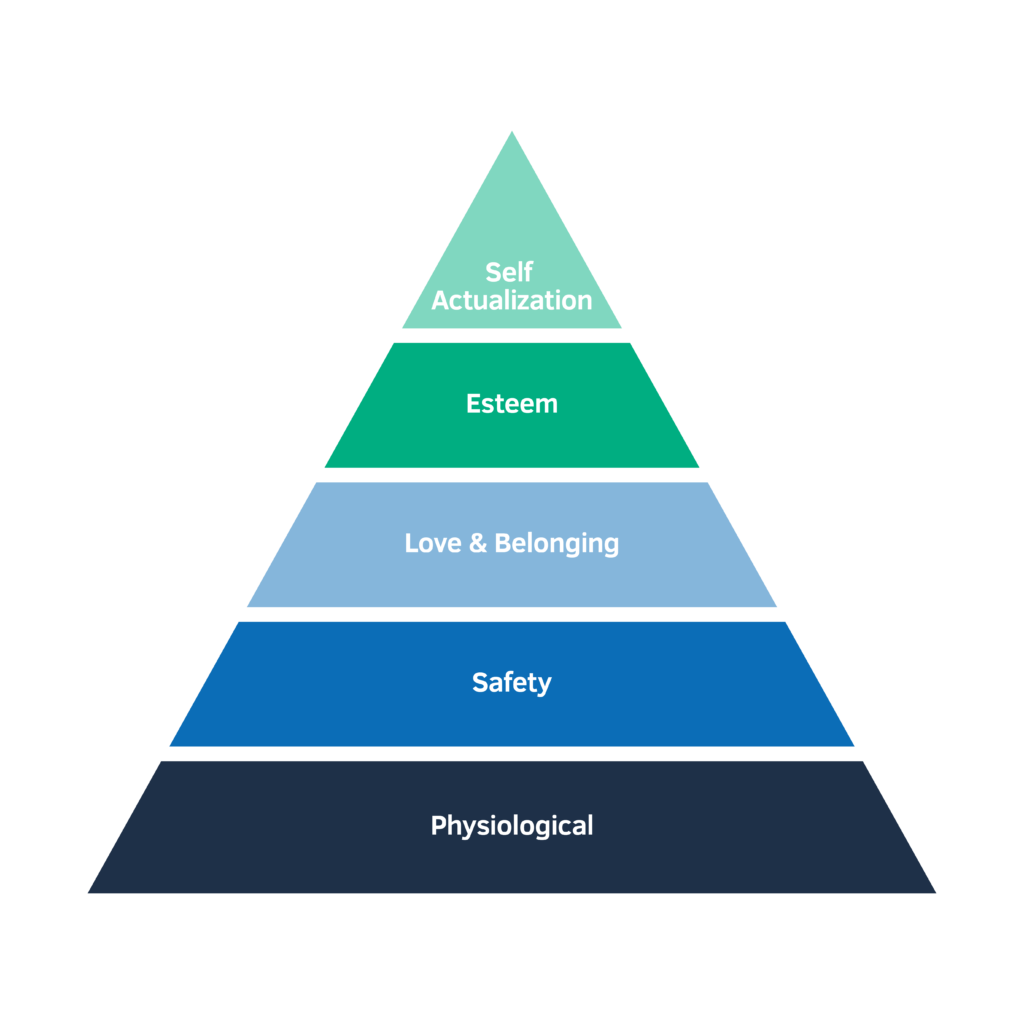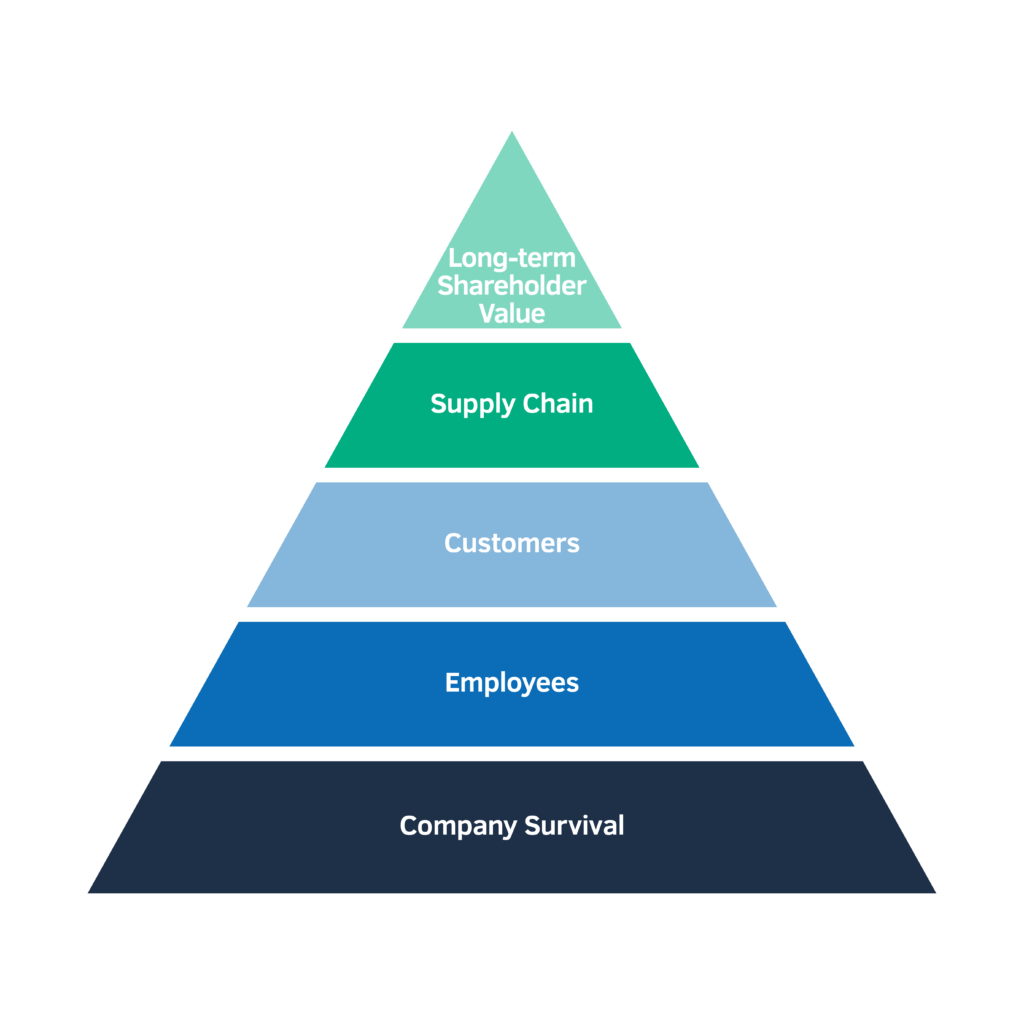
Amid unforeseen circumstances, how do companies prioritize their stakeholders?

Amid unforeseen circumstances, how do companies prioritize their stakeholders?
In his 1943 paper “A Theory of Human Motivation”, Abraham Maslow put forward his seminal theory on the “Hierarchy of Needs.” The theory describes how we as humans must fulfill certain basic needs before we can progress to higher levels of needs and desires. For example, humans need to eat so they are willing to forego safety if they can’t fulfill the need for food. Both of these basic needs precede psychological needs, such as relationships, friendships, and feelings of accomplishment. Maslow did not consider these needs to be direct trade-offs, but rather as a foundation for the level that follows.

Amid the extraordinary circumstances and economic difficulties brought on by COVID-19, companies in 2020 are faced with decisions on how to best serve the many stakeholders that rely on them – customers, investors, suppliers, employees, and so on. Each group has its own distinct needs and contributions to the company’s overall success, and companies recognize that these groups build on each other to serve their purpose. Like Maslow, so too can a company reach its “self-actualization” of long-term shareholder value by meeting various stakeholders’ priorities rather than viewing each as a trade-off for another.
Survival for the company itself represents the basic need of the hierarchy. A company’s first priority has to be ensuring it is resilient (and liquid) enough to outlast the crisis. If this need is not met, there are no employees, customers, or other stakeholders to serve. Hard decisions may have to be made to ensure the long-term survival of the enterprise that will affect other tiers of needs – closing stores, furloughing employees, or postponing dividends to investors. Once the basic need is met, however, and the company is a going concern, the company can reorient its focus.

Employees look to their employer for security in more ways than one – financial, to be sure, but also physical. Many companies addressed this area first in its response to COVID-19 – 89% of respondents to a recent FCLTGlobal survey indicated that employee health and safety was its top priority. Those companies that are viable will both do the right thing by focusing on the financial, as well as the physical, safety of their employees. For example, Cisco has committed to retaining its employees and urged other companies to follow the example when possible. Prioritizing employee wellbeing will engender loyalty to the firm, but also attract new talent in the period to follow.
Once the house is in order, customers’ needs can follow. Just as customers depend on a company’s products, the company relies on a consistent, repeatable client base to stay in operation. Like before, this tier is dependent on the one that precedes it – if there were no company, or no employees to keep it running, there would be no customers to serve. We see extraordinary examples of customer service in times of need from companies that have now become essential to people’s lives, in a crisis or otherwise. Amazon has secured its longstanding Prime subscriptions by monitoring price gouging of in-demand items, like paper goods and cleaning supplies. Supermarkets and other supply stores are keeping special operating hours specifically for the elderly. Companies across industries have converted their operations to make personal protective equipment in lieu of their typical (and less essential) offerings. Coming to customers’ aid in times of need help to ensure that they will continue to provide business well after the crisis as subsided.
Once customers’ needs are met and business can continue, the supply chain must be maintained. COVID-19 has presented a real challenge in terms of supply for many companies, particularly when sourcing products from countries that are in strict lockdowns. Like the rest of the hierarchy, this can prove a difficult task – a survey conducted by the Institute For Supply Chain Management showed that “nearly 75 percent of companies report supply chain disruptions in some capacity due to coronavirus-related transportation restrictions.” But companies must do whatever possible to see that their suppliers stay afloat, so that they can in turn provide for their customers, who provide for their employees, who keep the company in operation. Unilever, for example, has offered early payment for some small and medium sized suppliers to ensure their financial liquidity and survival.
Then, finally, the company is able to achieve long-term value for its shareholders. Meeting the preceding needs – viability through liquidity, employee wellbeing, extraordinary customer care, and supply chain continuity – may have resulted in near-term shortfalls for shareholders by way of lower earnings or a temporary pause in issuing dividends. But nowhere on our hierarchy do we see the short-term shareholder, who may be seeking a quick return in a difficult time. Forgoing that immediate profitability will render companies fully capable of serving their long-term shareholders for years to come because they have placed their emphasis on the areas that will make them viable well beyond the situation at hand. Where short-term-oriented investors may see this as a negative sign, shareholders who are a committed to company’s vision and purpose will read it as an indication of its ability not just to survive but to prosper. Were Maslow an economist rather than a psychologist, he would consider this to be a form of self-actualization, or reaching one’s full potential – the pinnacle of the hierarchy.
A company’s stakeholders are important to the firm and its success in unique ways. When managed strategically, stakeholder needs can be met without jeopardizing the future of the business, even when in the throes of a historic economic crisis. Companies that successfully navigate their own hierarchy will position themselves well to both weather the current storm and thrive in the long run.